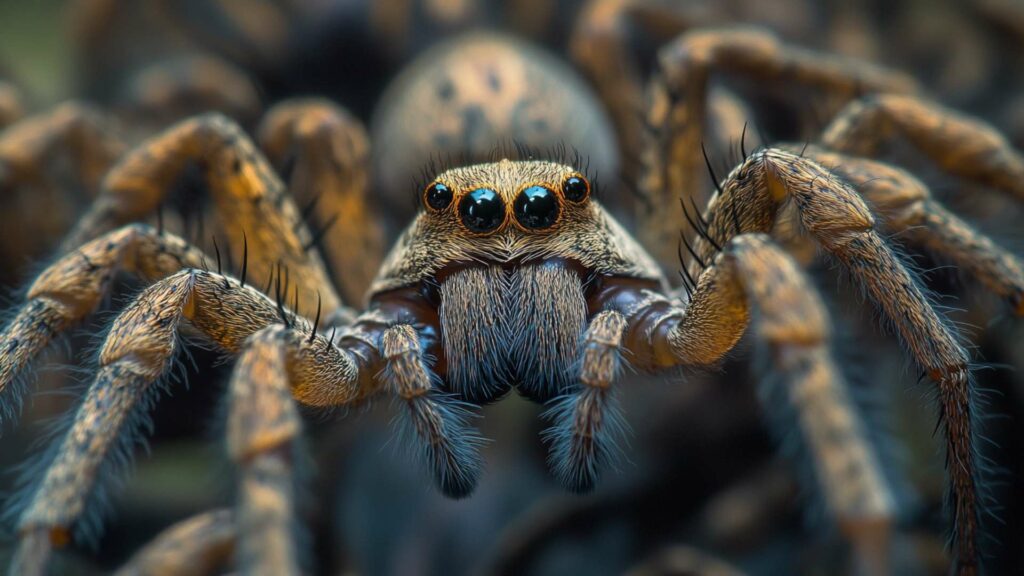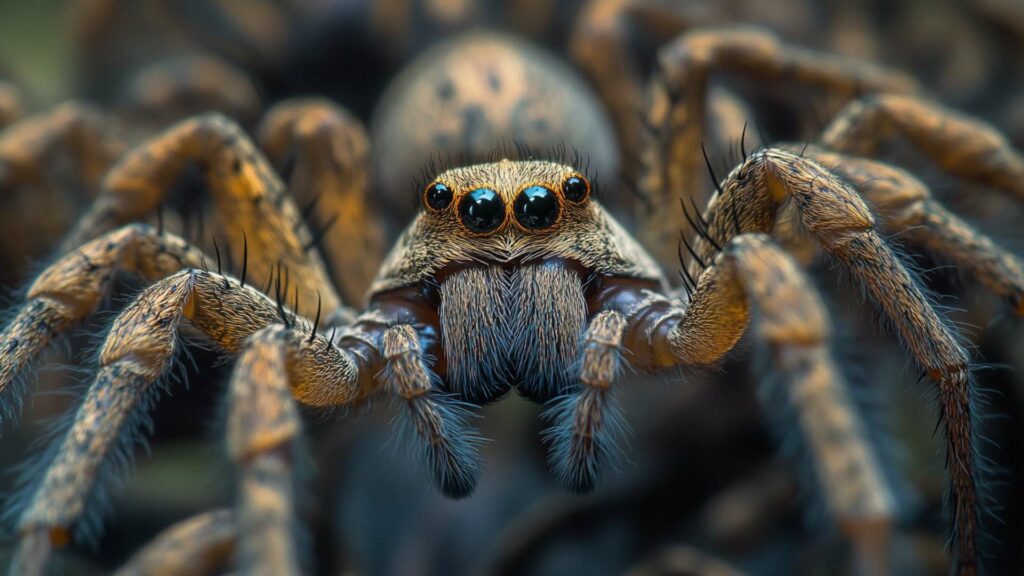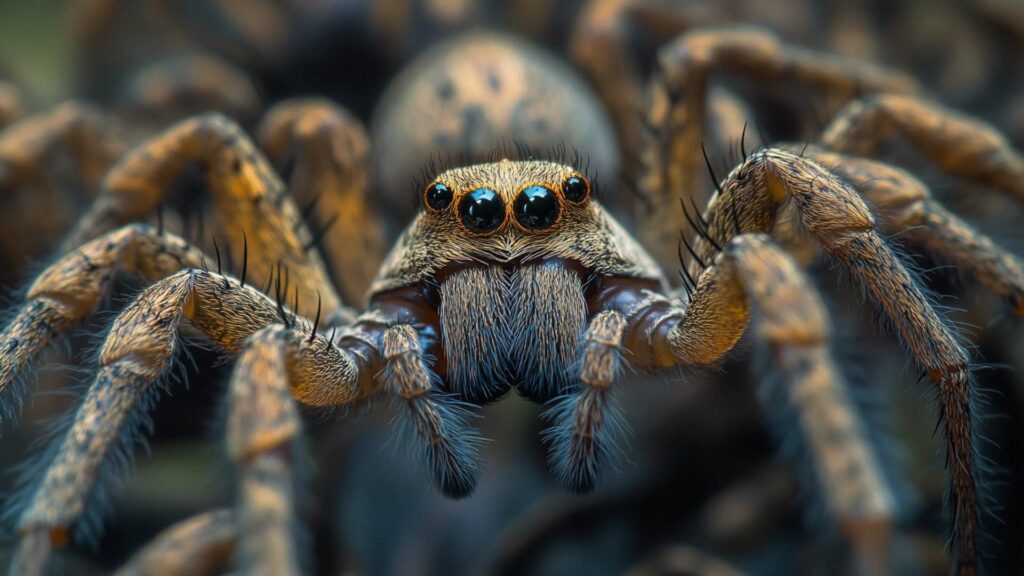A Closer Look at the World of Spiders
Ah, spiders, those fascinating little creatures that often send shivers down our spines. But beyond their eight legs and intricate webs, there is a world of wonder to explore. Did you know that spiders belong to the class Arachnida, which includes scorpions and ticks?
These arachnids are found in nearly every corner of our planet, from the depths of rainforests to the nooks and crannies of our homes. Spiders come in all shapes and sizes, from the tiny money spider to the impressive tarantula.
With around 50,000 known species worldwide and possibly many more yet to be discovered, spiders are a diverse group. They have adapted themselves brilliantly to their environments and developed an array of captivating survival tactics.
The Mystery Surrounding Hibernation
Now let’s turn our attention to hibernation—a concept familiar to many animals during cold months or periods of scarcity. But what happens to spiders when winter knocks on their door? Do spiders die as they curl up in cozy webs or burrow deep into the ground?
Well, it turns out that unraveling this mystery requires us to delve into the world of spider behavior and learn about whether these intriguing creatures truly hibernate. Hibernation is a well-known phenomenon among mammals like bears or hedgehogs who sleep through long winter months until spring arrives with its abundance once again.
But when it comes to spiders, things aren’t as clear-cut. While some may think spiders hibernate just like other animals do—becoming completely inactive and waiting for warmer days—the reality is far more nuanced.
Spiders have evolved complex strategies for surviving cold temperatures and scarcity during winter. Some species continue their activities unabated while others enter a dormant state similar but not identical to true hibernation—diapause.
Understanding this mesmerizing aspect of spider behavior illuminates the unique ways these creatures adapt to survive in their often harsh environments. So, let’s embark on this journey together and discover what really happens when the cold months arrive for our eight-legged friends.
Understanding Spider Behavior
Explanation of spiders’ cold-blooded nature and its impact on their activity levels
Spiders, like many other cold-blooded creatures, rely on the environment to regulate their body temperature. Unlike warm-blooded animals that can generate heat internally, spiders’ body temperature is largely dependent on external factors.
This means that as temperatures drop, so does the activity level of spiders. They become less active and slow down their movements as a result of their cold-blooded nature.
When exposed to colder temperatures, spiders’ metabolic rates decrease significantly. This reduction in spiders’ live metabolic activity allows them to conserve energy during times when food sources may be scarce.
Their bodies enter a state of lower energy consumption, enabling them to survive for longer periods without feeding. This slowdown in metabolism is also crucial for how spiders survive during hibernation or hibernation-like states.
Overview of different spider species and their varied behaviors
The behavior of spiders during colder months varies greatly among different species. Some spider species exhibit true hibernation-like behavior while others have developed unique strategies to survive the very cold weather. For instance, wolf spiders are known for being highly active even during winter months.
These resilient creatures do not hibernate but rather adapt to the cold by actively hunting throughout the year. They are equipped with specialized adaptations such as hairs on their legs that aid in retaining heat and enable them to move more efficiently over snow-covered terrain.
On the other hand, certain orb-weaving spider species undergo diapause—a state similar to hibernation—during colder periods. These spiders seek out sheltered locations like cracks in rocks or crevices in tree bark where they can curl up and become dormant until warmer conditions return.
During this time, they remain primarily inactive and conserve energy until spring arrives when they resume building intricate webs to capture insects. Understanding spider behavior requires recognizing their cold-blooded nature and the impact it has on their activity levels.
While some spider species, like the wolf spiders, remain active even in colder temperatures, others adopt hibernation-like states to survive through periods of scarcity and harsh weather. Their ability to adapt to changing conditions showcases the remarkable diversity within the spider kingdom.
Do Spiders Hibernate?

Definition of Hibernation and its Purpose
Hibernation is a well-known phenomenon observed in many animals, particularly mammals, where they enter a state of prolonged sleep or dormancy during cold winter months. The purpose of hibernation is to conserve energy and survive when food sources are scarce.
During hibernation, animals experience a significant reduction in their metabolic rate, body temperature, and overall activity levels. This incredible adaptation allows them to endure harsh conditions until more favorable circumstances return.
Discussion on Spider Hibernation
When it comes to spiders, the concept of hibernation becomes slightly more complex. Unlike mammals and other insects that enter deep sleep for an extended period, spiders exhibit behaviors that resemble hibernation but have certain distinctions. Many spiders do show reduced activity during colder months when food becomes scarce and temperatures drop significantly.
However, their version of hibernation is not as extensive as that experienced by mammals. While some spider species become dormant or less active during winter seasons, others continue with their usual daily activities despite the cold temperatures.
House spiders, for instance, often seek refuge in warm indoor spaces like basements or crawl spaces during the colder months but remain relatively active throughout winter. Furthermore, certain outdoor spiders may lay eggs during early fall and then protect the egg sacs until spring arrives when their offspring hatch.
It’s important to note that most spiders do not possess antifreeze compounds in their bodies like some insects do to survive freezing temperatures actively. Instead, they rely on seeking shelter in protected areas or employing physiological adaptations to withstand colder conditions without freezing entirely.
So while spiders may not undergo true hibernation as observed in mammals, they do exhibit various behaviors aimed at surviving the winter season and ensuring future generations thrive. While “hibernation” may not be precisely what happens to spiders during the colder months, their behavior certainly reflects a strategy for coping with adverse conditions.
Whether it’s seeking warmth indoors, laying eggs to keep them warm until spring, or reducing overall activity levels to conserve energy, spiders demonstrate remarkable adaptations to thrive in different environments. Understanding these behaviors enhances our appreciation for the resilience and complexity of these often misunderstood arachnids.
Seasonal Adaptations in Spiders
Examination of spiders’ response to changing seasons
Spiders, like many other cold-blooded creatures, are highly attuned to the changing seasons. As winter approaches and temperatures drop, spiders modify their behavior and habits to ensure survival during the harsh conditions.
One of the most notable adaptations is their ability to sense the upcoming go in the winter and season and prepare accordingly. They instinctively know when it’s time to adjust their activities and find suitable shelters to protect themselves from freezing temperatures.
Description of diapause, a state similar to hibernation, observed in certain spider species during winter months

During the winter months, some spider species enter a state known as diapause. Diapause is similar to hibernation in mammals but has its own unique characteristics. It is an extended period of reduced metabolic activity that helps spiders conserve energy and survive through unfavorable environmental conditions.
In this state, spiders become less active and slow down their bodily functions significantly. Diapause allows spiders to endure harsh winters when food sources are scarce or non-existent.
They withdraw from actively hunting or web-building activities and focus on minimizing energy expenditure. It’s worth noting that not all spider species go into diapause during winter; only certain ones have evolved this particular adaptation.
Notable examples of seasonal adaptations in different spider species
Various spider species exhibit remarkable seasonal adaptations depending on their specific life cycles and habitats. For instance, tree bark spiders in the winter have been observed laying eggs inside an egg sac that acts as a protective shield against cold temperatures while ensuring survival until spring arrives. Web-building spiders also adapt by either seeking warmth in human-made structures such as houses or by constructing thicker webs that provide better insulation against the colder weather conditions.
Jumping spiders tend to hibernate individually inside cracks or crevices where they can find some shelter from the freezing temperatures. Overall, spiders have developed a range of strategies to cope with the challenges presented by winter seasons.
Through diapause or other adaptive behaviors, they are able to conserve energy, withstand harsh climates, and emerge ready to resume their activities when spring arrives. These seasonal adaptations not only ensure their survival but also contribute to maintaining ecological balance and controlling pest populations in their respective habitats.
Spider Hibernacula: Where Do They Seek Shelter?

Exploration of various hiding places spiders use during colder months
As winter arrives, spiders, like many other cold-blooded creatures, need to find shelter from the harsher elements. They have various hiding places where they seek warmth and refuge during the colder months. One common spot is cracks and crevices in natural habitats.
These small gaps provide a secure environment where spiders can shelter themselves from the cold winds and freezing temperatures that winter brings. Spiders often find solace in the cozy confines of tree bark crevices, rock fissures, or even underground burrows they create themselves.
Another popular haven for spiders seeking warmth and protection is human-made structures such as houses, sheds, and garages. These man-made environments offer a welcoming escape for our eight-legged friends.
Spiders take advantage of nooks and crannies found within these structures to spin their webs or build webs in their retreats. Attics, basements, and storage areas often become hotspots for spider activity during winter months as they provide insulation against the chill outside.
Cracks, crevices, and burrows in natural habitats

In their quest to survive winter’s chill, spiders utilize a variety of natural hiding spots that offer protection from the elements. Cracks and crevices in rocks or trees act as mini caverns where spiders can take refuge when temperatures drop.
These tiny gaps provide insulation against the biting cold air outside while also serving as perfect ambush points for unsuspecting insects passing by. Burrows are another favored choice for certain spider species seeking shelter during winter months.
Some spiders construct intricate tunnels beneath the ground using silk threads mixed with soil particles to create sturdy chambers that safeguard them from temperature extremes above ground level. These burrows not only provide protection but also serve as strategic hunting spots once spring arrives and prey becomes more abundant.
Human-made structures like houses, sheds, and garages

Spiders have become well-adapted to thriving in close proximity to humans. Our homes, sheds, and garages inadvertently offer spiders an enticing opportunity for survival during colder periods.
The spaces between walls or inside attics provide warm and protected environments where spiders can thrive. Often, we encounter their intricate webs adorning the corners of our rooms or lurking in the corners of our garages.
Spiders take advantage of human-made structures for two primary reasons: shelter and access to potential prey. The warmth generated by our heating systems creates a microclimate within these buildings that provides a cozy retreat from the frigid outdoor temperatures.
Additionally, indoor pests such as flies or mosquitoes can inadvertently find their way inside during winter months, becoming an easy food source for spiders seeking sustenance during leaner times. Spiders employ various hiding places to survive the winter months when temperatures drop significantly.
Whether they seek refuge in cracks and crevices found in natural habitats or take advantage of human-made structures like houses and sheds, these arachnids display remarkable adaptability in finding shelter from the cold. By understanding where spiders hibernate, we gain insight into their behavior and appreciate their role in pest control while coexisting with them even during the colder seasons.
The Science Behind Spider Hibernation
Slowing Down Metabolic Rate: A Winter Slumber
As the temperatures drop and the late summer and winter seasons approach, spiders undergo remarkable physiological changes to ensure their survival in harsh weather conditions. One of the key adaptations is slowing down their metabolic rate, akin to entering a deep slumber.
This reduction in metabolic activity allows spiders to conserve energy, as they enter a state of dormancy that resembles hibernation. During this time, their bodily functions slow down significantly, including respiration and digestion.
By conserving vital resources, spiders can endure the scarcity of prey during colder months. This metabolic slowdown also helps spiders stay warm when external temperatures plummet.
Since cold-blooded creatures like spiders rely on environmental heat sources to regulate their body temperature, reducing metabolic activity is crucial for maintaining an optimal level of warmth. As the spider’s metabolism slows down, it generates less heat internally and becomes more dependent on external heat sources to stay comfortable.
Adaptations for Surviving Low Temperatures: Nature’s Winter Coats
To withstand freezing temperatures and survive through winter seasons, spiders have evolved fascinating adaptations that enable them to brave the cold with resilience and ingenuity. One such adaptation is an alteration in their body fluids.
Spiders produce special antifreeze compounds called cryoprotectants that prevent ice crystals from forming within their cells when exposed to extreme cold. These cryoprotectants lower the freezing point of bodily fluids, allowing spiders to withstand sub-zero temperatures without sustaining cellular damage.
In addition to cryoprotectants, some spider species possess unique physical structures that aid in surviving harsh winter conditions. For instance, certain outdoor spiders construct hibernacula – protective shelters made from silk and debris – where they retreat during winter months.
Others seek refuge under rocks or within crevices or crawl spaces near human-made structures. By finding suitable hiding places, spiders can shield themselves from the harshest elements and ensure their survival until springtime arrives.
Spiders Reemerge: A Triumph Over Winter’s Grasp
As the winter season subsides and temperature gradually rises, spiders emerge from their hibernation-like states with renewed vigor. The resumption of their normal metabolic rate signifies the end of their winter slumber. For some species, this emergence coincides with the mating season and an opportunity to lay eggs for future generations.
Spiders that build intricate webs such as orb-weavers and web-building spiders diligently reconstruct their webs, while agile hunters like jumping spiders and wolf spiders embark on a quest for prey. Although hibernation is not precisely the term to describe spider winter survival strategy, it remains remarkable how these arachnids adapt to nature’s changing seasons.
Through modifications in metabolic rate and ingenious physiological adaptations to withstand low temperatures, spiders exhibit a resilience that allows them to thrive even in harsh conditions. Their ability to survive winter showcases the fascinating diversity of strategies in nature’s arsenal – reminding us of the intricate wonders that lie within every corner of our natural world.
Notable Examples: Spiders with Unique Hibernation Strategies
1. The Garden Orb-Weaver Spider’s Ability to Survive Freezing TemperaturesIn the realm of spider hibernation, one remarkable species that stands out is the garden orb-weaver spider. These delicate yet resilient creatures have developed an adaptive mechanism to endure freezing temperatures during winter months. Rather than seeking shelter in crawl spaces or storage areas like some other spiders, they exhibit a behavior known as “freeze tolerance.” When temperatures drop drastically, the garden orb-weaver spider undergoes a biological transformation that allows it to survive in sub-zero conditions. As winter approaches, these arachnids begin preparing by producing special proteins called cryoprotectants. These proteins act as antifreeze agents within their bodies, preventing their cells from crystallizing and sustaining damage. As colder temperatures envelop their habitat, the garden orb-weaver spider slows down its metabolic activities to an almost dormant state. It suspends its web-building endeavors and retreats into protective nooks such as rock piles or beneath tree bark where it can remain undisturbed throughout winter seasons. When warmer days arrive and spring awakens nature from its slumber, these resilient spiders emerge once again to resume their web-building ventures.
2. The Wolf Spider’s Active Hunting Even During Winter MonthsUnlike many species that retreat into hibernation-like states during winter months, wolf spiders defy convention by remaining actively engaged in hunting and survival throughout the colder seasons. These agile predators are known for their exceptional adaptability to various habitats and climates. Rather than waiting idly for better times like some other arachnids, wolf spiders continue their relentless pursuit of prey even when temperatures plummet. Their robust bodies enable them to withstand harsh conditions without compromising agility or predatory prowess. During winter periods when insects become scarce due to their own hibernation or migration, wolf spiders adjust their hunting strategies accordingly. They employ their sharp senses and keen eyesight to locate potential food sources, often seeking out smaller invertebrates such as beetles or larvae hidden beneath leaf litter or soil. By maintaining activity levels throughout winter, wolf spiders ensure that they remain well-fed and prepared for the coming seasons. While other spider species may emerge famished after a long period of dormancy, these spiders survive winter because these industrious hunters can readily seize opportunities as soon as favorable conditions arise. While some spiders undergo traditional hibernation-like states during colder temperatures, others have developed unique strategies to survive and even thrive through winter months. The garden orb-weaver spider’s remarkable ability to endure freezing temperatures showcases its exceptional adaptation skills, utilizing cryoprotectants and a slowed metabolic state. Conversely, the wolf spider stands out for its active hunting nature throughout the year, even during winter periods when prey may be scarce. The fascinating world of spider hibernation reveals the diverse ways these remarkable creatures navigate the challenges imposed by varying climates and seasons.
Life after “Hibernation”
A New Dawn: How Spiders Emerge from Their Cozy Slumber
As winter seasons pass and temperatures drop, spiders begin to emerge from their hibernation-like states, gradually awakening to a world transformed. Unlike warm-blooded creatures that maintain a constant body temperature, spiders’ cold-blooded nature allows them to adapt to changing environmental conditions.
When the weather starts to warm up in early spring, these eight-legged wonders stir from their cozy spots and prepare for a fresh start. For many spider species, emerging from hibernation means embarking on the next phase of their life cycle.
Female spiders that entered hibernation with an egg sac will find themselves faced with an important task: finding a suitable location to lay their eggs. These industrious arachnids instinctively seek out safe and sheltered spots where they can protect their precious cargo from predators and harsh weather conditions.
The Miracle of Life: From Eggs to Baby Spiders
When the female spider finds the perfect spot, she carefully deposits her eggs in a protective sac. Mother Nature has equipped these remarkable creatures with an astonishing ability – some spider species are known for generating heat within the egg sac through metabolic processes.
This exceptional adaptation keeps the developing eggs warm even during freezing temperatures, ensuring the survival of future generations. After incubating for several weeks or months (depending on the species), the eggs hatch into tiny spiderlings eagerly bursting into existence.
These miniature spiders immediately embark on their own adventures, navigating through their surroundings using instinctual behaviors unique to each species. Some baby spiders are capable of producing silk threads and embark on incredible journeys by ballooning through the air, while others rely on camouflage or innate hunting skills passed down through generations.
Conclusion
The wondrous world of spider hibernation offers us profound insights into the resilience and adaptability of these remarkable creatures. As temperatures drop and nature slows down, spiders find ways to survive and even thrive during the challenging winter months.
From finding cozy hibernacula to protecting their eggs and raising a new generation, spiders’ ability to overcome adversity is truly awe-inspiring. So, the next time you come across a spider scuttling across your path or spinning an intricate web in your backyard, take a moment to appreciate the incredible journey it has undergone.
In their own unique way, spiders teach us the importance of perseverance and adaptation in the face of adversity. Let us be inspired by these extraordinary arachnids, for there is always something remarkable happening in the hidden world of spiders.
Defeat Spiders with D-Termination: The Foremost Pest Control Service in Las Vegas!

If you’re worried about spiders invading your Las Vegas property, fear not! D-Termination has the ideal solution for you. Our team of experts is highly skilled at eradicating spider infestations, bringing back peace and tranquility to your space. Bid farewell to spiders by opting for D-Termination’s effective pest control today!
To book your spider control service and reclaim your space from these unwanted pests, contact us at 702-919-6310 or visit dtermination.com.
Frequently Asked Questions:
Spiders may enter a state of dormancy or seek shelter during winter.
Some spider species die off in winter, while others survive through various strategies.
Spiders often find shelter in secluded areas inside houses during winter.
The lifespan of a spider varies greatly depending on the species, ranging from a few months to several years.








